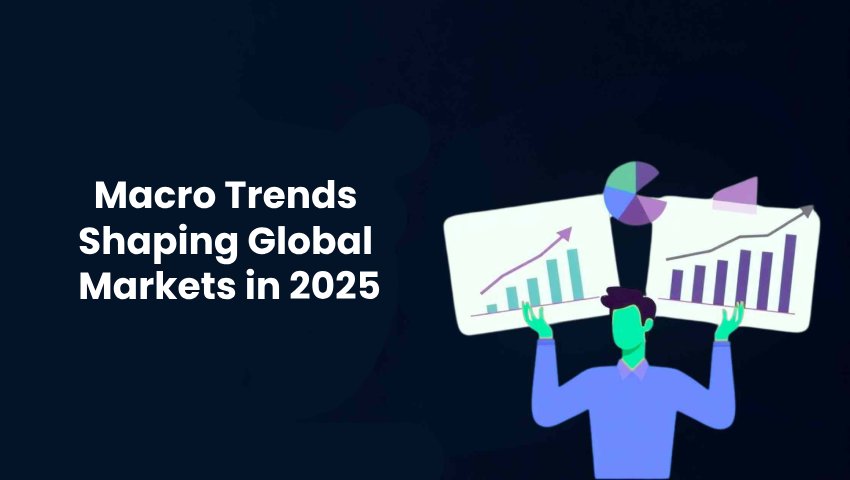
- 18/06/2025
- MyFinanceGyan
- 456 Views
- 3 Likes
- Share Market
Macro Trends Shaping Global Markets in 2025
Is a global recession imminent? Will trade wars destabilize financial markets? What sectors are expected to perform well? These are common questions that investors—both seasoned and new—are asking in 2025. With geopolitical uncertainty, technological disruption, and economic shifts in motion, understanding macro trends is more crucial than ever. In this article, we’ll explore the major macroeconomic trends shaping global markets in 2025, identify key indicators to watch, and outline sectors that may offer growth opportunities.
What Are Macro Trends?
Macro trends refer to long-term, large-scale shifts in the global economic, political, social, and technological landscape. These trends influence everything—from consumer behavior and business models to investment strategies and government policies. For example, automation started as a niche advancement in a few sectors and is now a global phenomenon influencing industries and daily life. Similarly, in 2025, trends like artificial intelligence (AI), geopolitical realignments, and energy transition are playing defining roles in global markets.
Key Economic Indicators to Watch in 2025:
Despite signs of recovery, 2025 continues to be a year of economic volatility. Here are five critical indicators investors and analysts should monitor closely:
- GDP Growth Rate: The Gross Domestic Product (GDP) measures a country’s economic output. With global economic slowdowns under discussion, GDP growth rates will be a major barometer of health and direction for economies in 2025.
- Unemployment Rate: A low unemployment rate indicates a stable economy. However, with AI and automation replacing some jobs and fears of a slowdown looming, the unemployment rate is a red flag worth tracking this year.
- Stock Market Performance: Equity markets reflect investor sentiment, business valuations, and expectations. With trade tensions and inflation concerns, global stock markets remain volatile. Index trends will continue to offer clues about market confidence.
- Inflation: Rising prices were a major concern through the early 2020s. Although inflation is cooling in some economies, it still impacts purchasing power, monetary policy, and business margins.
- Interest Rates: Interest rates affect loans, savings, corporate investments, and even currency strength. In 2025, central banks are balancing between curbing inflation and supporting economic growth, making interest rates a critical watchpoint.
Emerging Market Dynamics in 2025:
Emerging economies such as India, Brazil, Indonesia, and Thailand have historically attracted global investment due to their growth potential. But in 2025, these markets are facing challenges.
Key Factors Impacting Emerging Markets:
- High Inflation & Currency Volatility
- Employment Slowdown
- Trade Barriers and Sanctions
- Strong US Dollar Impact
Though growth continues, the pace has moderated. Investors should be mindful of policy changes, foreign capital flows, and global demand when considering emerging market exposure.
Technological Disruptions Transforming Global Markets:
Technology continues to be a dominant force in shaping the global economy. Here are some notable developments in 2025:
- Artificial Intelligence (AI): AI has moved beyond automation. Advancements such as metacognitive AI are improving decision-making and adaptability in systems, impacting industries like finance, healthcare, logistics, and retail.
- Green Fuels & Battery Technology: With climate action a global priority, investment is flowing into green energy and energy storage. Ferro-phosphate batteries are expected to revolutionize the electric vehicle (EV) sector by enhancing range and reducing costs.
- Healthcare Innovation: Technological breakthroughs in drug delivery, remote diagnostics, and GLP-1 receptor antagonists are disrupting traditional healthcare systems and improving patient outcomes.
Geopolitical Shifts: Risks and Realignments:
Geopolitical developments are having a significant influence on global market dynamics in 2025. Conflicts, alliances, trade wars, and demographic pressures are creating uncertainty across sectors.
Major Geopolitical Risk Areas:
- Ongoing military conflicts
- Climate change and environmental instability
- Supply chain disruptions
- Trade sanctions and tariff changes
These uncertainties often lead to lower investor confidence and capital flight, especially from volatile regions. Businesses and investors must remain agile in response to policy changes and geopolitical events.
Sector-Specific Opportunities & Challenges in 2025:
Despite global uncertainties, several sectors are showing resilience and potential for growth, particularly in markets like India.
Promising Sectors:
- Information Technology: Demand for cloud, cybersecurity, and AI talent remains strong.
- Green Energy & Renewables: Driven by global sustainability goals.
- Healthcare & Pharmaceuticals: Boosted by innovation and rising health awareness.
- Infrastructure & Capital Goods: Fueled by government spending and public-private partnerships.
- Electric Vehicles (EVs): Adoption rates are increasing, supported by favorable policies.
Sectors to Watch for Risk: Industries dependent on global trade, sensitive to interest rate fluctuations, or with tight margins may face headwinds. These include traditional manufacturing, export-heavy sectors, and real estate in certain markets.
Conclusion: Stay Informed, Stay Agile:
The global economy is undergoing a transformation. While predicting the future with certainty is impossible, understanding macro trends and key indicators helps investors make informed decisions. Stay updated, review your portfolio periodically, and remain flexible to adapt to new risks and opportunities.
FAQs:
Macro trends are long-term, large-scale developments that shape industries, influence investment patterns, and affect consumer behavior globally.
Rising inflation reduces consumer spending and business profits, leading to lower investor confidence and stock prices.
Technology, green energy, healthcare, infrastructure, and electric vehicles are projected to experience growth.
They create uncertainty, disrupt supply chains, and negatively affect investor sentiment and business continuity.
AI is transforming operations, enhancing productivity, and opening new opportunities in various sectors, making it a critical trend to watch.
Disclaimer:
The views expressed in this article are those of the author. This content is for educational purposes only and not a recommendation for any investment product or strategy.



